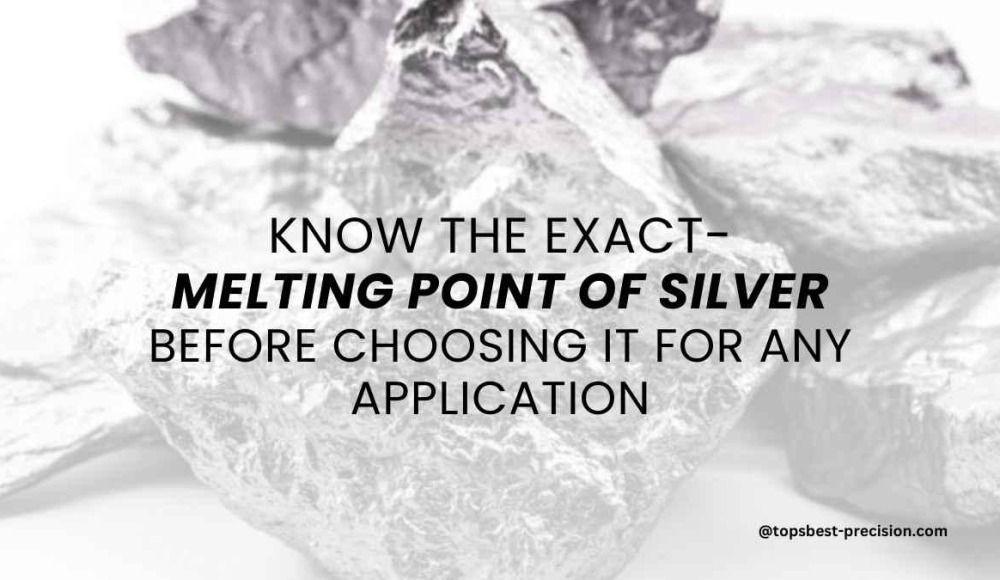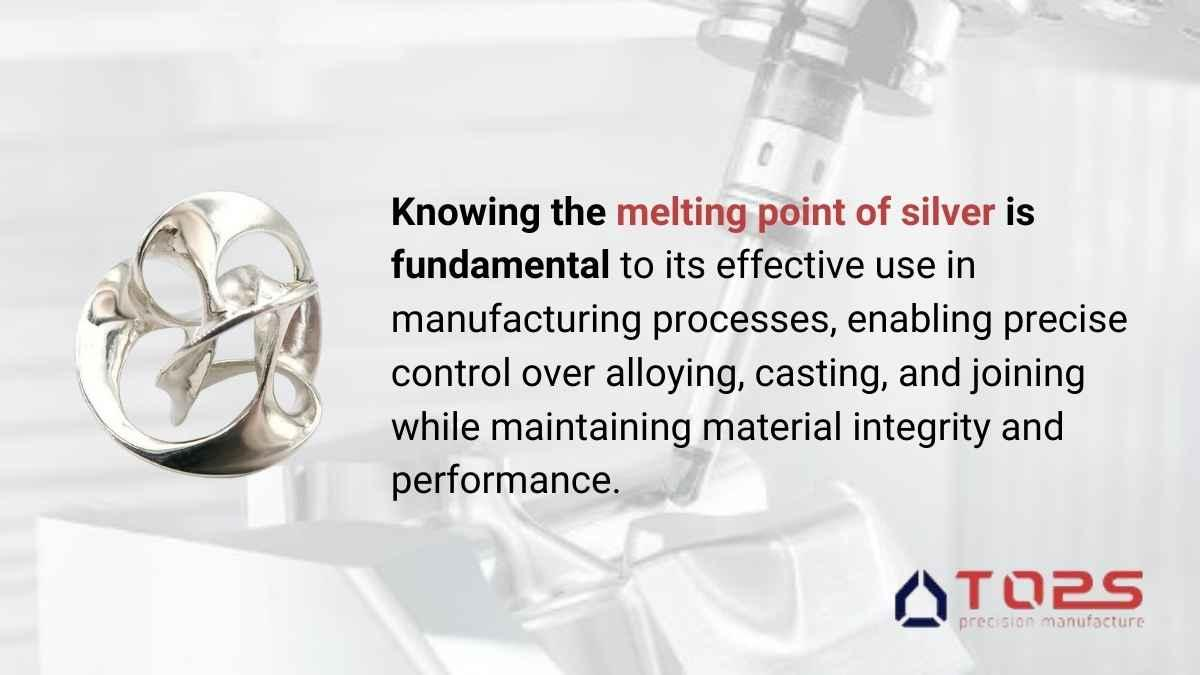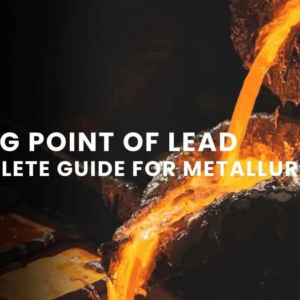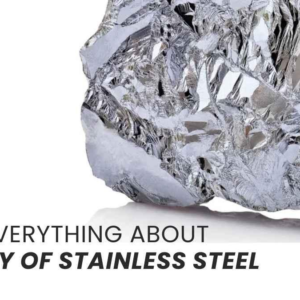Do You know the melting point of silver? This critical property can greatly impact the success of your project. If you select silver without knowing the exact melting point you might end up with inefficient processing or even material failure. Knowing silver’s exact melting point helps you achieve better results when casting, soldering, or alloying. This precise temperature is key for making the right choice in each application.
What is the Melting Point of Silver?
The melting point of the silver is 961.8 °C (1763.2 F). At this the silver changes from solid to liquid form. Silver is relatively easy to melt, but has a higher melting point than other metals, which is why it’s perfect for use in applications that require the material to be strong and stable at high temperatures. Understanding its thermal aspects enables metallurgists to maneuver around the metal with exceptional benefits, and accuracy in products.
Factors Affect the Melting Point of Silver
The melting point is determined based on composition, purity, atomic size, pace, and conditions at which heat is being applied, and melting conditions. These factors define the physical properties of silver especially its characteristic under heat and its adaption to the different uses in industries.
1. Purity
Pure silver has a melting point of 961.8°C (1763.2°F). Dopants, such as other metallic elements or compounds, lower the melting point. Jewelry and electronic parts require precise temperatures that melt higher-purity silver to be uniform and of predictable character.
2. Atomic Size
Atomic size is a key factor in silver’s melting point. Compared to other metals, the silver atoms are relatively large, which affects their behavior. Larger atoms are easier to break up, and phase changes are relatively convenient. The atomic size of silver causes melt at a lower temperature than metals like gold or platinum.
3. Heating Rate
The fast rate of heating leads to localized melting and oxidation. The slow rate of heating will make it to be heated uniformly. Accuracy of heat input is desired especially in casting or soldering where high temperatures are needed and exact degrees are needed to be achieved.
4. Pressure
In different pressure conditions, the silver melting point can be changed. In higher pressure conditions the melting point usually rises normally as expected. On the other hand, it may be reduced at lower pressures. This is especially true in enclosed manufacturing environments. It also applies in areas with low atmospheric pressure, such as high altitudes.
5. Temperature Gradients
Temperature gradients are referred to as temperature distribution across the whole material of silver. Uniformity of the temperature distribution during the actual melting process is critical to avoid producing defects, especially for large-scale use in industries.
6. Isentropic Conditions
A steady flow process occurs when there is no change in the entropy of the working fluid. Isentropic coefficients depict processes that happen without heat exchange. Under such conditions, the possibility of a change in the melting point of silver may be due to the lack of transfer of heat energy. However, it’s a slightly more theoretical consideration but can play a role in high-accuracy applications, e.g. vacuum melting, and certain high-speed manufacturing technologies when entropy stability affects phase change.
Comparing the Melting Point of Silver to Other Metals
The table provides a comparative analysis of the melting points of silver and other metals in Celsius, Fahrenheit, and Kelvin scales.
| Metal | Celsius (°C) | Fahrenheit (°F) | Kelvin (K) |
| Silver | 961.8°C | 1763.2°F | 1234.95 K |
| Gold | 1064°C | 1947.2°F | 1337.15 K |
| Copper | 1084°C | 1983.2°F | 1357.15 K |
| Lead | 327.5°C | 621.5°F | 600.65 K |
| Iron | 1538°C | 2800.4°F | 1811.15 K |
| Aluminum | 660.3°C | 1220.5°F | 933.45 K |
| Platinum | 1770°C | 3218°F | 2043.15 K |
| Zinc | 419.5°C | 787.1°F | 692.65 K |
| Nickel | 1455°C | 2651°F | 1728.15 K |
| Titanium | 1668°C | 3034.4°F | 1941.15 K |
How to Melt Silver Metal?
To melt silver you have to pay close attention to temperature and use proper equipment for processing silver safely. If you are using pure silver or a silver mixture, then knowing the right process can help avoid faults and get a perfect melt.
1. Prepare the Silver
The initial step always requires you to wash the silver piece and unwanted particles, blemish, or tarnish. If you are working with scrap silver it is advisable to ensure the silver you are using is not contaminated to impact the melting.
2. Choose the Right Crucible
Select your crucible to be hard and heat-resistant material such as graphite, clay, or ceramic. The crucible must be in a position to withstand temperatures higher than the melting point of silver. However, the crucible should be clean and dry before use.
3. Heating the Silver
To melt silver, you will require a heat source that must be capable of providing heat above its melting point (961.8°C). You may use a propane torch, or an electric furnace/kiln. If using a torch, the chances of the metal cracking since the heat is applied suddenly, should be directed evenly on the silver.
- Torch: Rotate the flame over the silver to be even and wait until the silver turns slightly orange.
- Furnace/Kiln: The furnace/kiln should be preheated, and the heat should be aggressively maintained approximately at 1000°C.
4. Monitor the Temperature
To monitor the temperature, use a pyrometer or temperature sensor to ensure silver has reached its optimal melting point. Because overheating can lead to oxidation.
5. Melt the Silver
For a better and even melting just stir gently if needed. If there seems to be any dirt on the silver surface, use a flux or skimming tool and remove it.
6. Pour the Molten Silver
When the silver is fully liquified then pour the liquified silver on molds of the desired shape. Be careful though, molten silver can be dangerous and may cause third-degree burns. Moreover, the abrupt temperature changes can cause the mold to crack.
7. Allow to Cool and Solidify
Allow the silver to cool and crystallize forming the mold. Cooling may take several minutes to an hour depending on the size. After solidifying, take out the silver from the mold.
8. Post-Melting Cleaning
In case you want to make the surface of the silver shiny again, you will need to polish the piece after the silver has set. The desired sleek can be achieved using the pickling solution. Moreover, you can use polishing cloths as well.
Melting Different Grades of Silver
The process of melting the silver differs from one grade to the other. Each grade of silver demands certain procedures to obtain the best possible outcome. Let’s compare the melting process of silver based on purity, alloy content, and its intended use.
1. Pure Silver (99.9% Silver)
Pure silver is ductile and can be easily cast because it fuses uniformly due to the low coefficient of thermal expansion.
Melting Point:8°C (1763.2°F)
- Applications: Jewelry, fine crafts, and electronics.
2. Sterling Silver (92.5% Silver)
Sterling silver features copper to make it stronger enough but it does slightly alter how the silver melts.
- Melting Point: With the range of 893°C to 946°C (1639°F to 1735°F).
- Applications: Jewellery, cutlery, and ornaments.
3. Argentium Silver (92.5% Silver with Germanium)
Argentium silver imparts to it greater protection against tarnish and increased serviceability.
- Melting Point: Like sterling silver, it is melted at temperatures of 900 to 950 Celsius (1652-1742 Fahrenheit).
- Applications: Luxury jewelry accessories, Silver cutlery products.
4. Coin Silver (90% Silver)
Coin silver is commonly employed in producing U.S. silver coins consisting of 90% silver and 10% copper. The melting point of coin silver is slightly less than that for S.S.
- Melting Point: About 890°C to 925°C (1634°F to 1697°F)
- Applications: Coins, antique jewelry, forks, spoons, etc.
5. Mexican Silver ( 92% Silver)
Mexican silver means silver that is usually 92.5% pure silver and above. However often it contains traces of copper or other impurities. The melting point of Mexican silver is slightly lower than sterling silver but higher than pure silver, depending on the alloy content.
- Melting Point: Usually ranging between 900 and 950°C (1652 and 1742°F)
- Applications: Jewelry, souvenirs and ornaments, and trinkets and trappings.
6. Silver-Plated Alloys
Silver-plated are metals with a layer of silver on a substrate material such as copper, brass, or stainless steel. These alloys also typically depend on the base metal. However, when melting silver-plated items, you have to be very cautious because base metals may cause an undesirable reaction.
- Melting Point: Depending on the base metal, it is in the range of 900-1500° C (1652 – 2732° F).
- Applications: Silver-plated jewelry, home decorations, and fashion accessories
Why It Is Essential To Understand Silver Melting Point?
In cases of jewelry, electronics, or any other process that involves the use of silvers, it is economically and safety-wise efficient as well as very accurate to know the exact point at which it melts.
1. Ensures Precision in Casting
The casting process especially the forming process requires precise temp control. Molten silver must be heated to the exact melting point. This ensures it has the right flow consistency when poured into a mold. Insufficient or excessive heat can cause defects like bubbles, cracks, or incomplete mold filling, resulting in a substandard end product.
2. Prevent Overheating
Silver is an active metal that oxidizes easily when heated. Heating it beyond its melting point causes surface oxides, which can affect the quality of precision applications like electronics or jewelry.
3. Improves Soldering and Alloying
For soldering and alloying uses, silver’s melting point is perhaps the single most important factor in the process. In general, the melting point of silver alloys is lower than that of pure silver, and accurate determination of these temperatures allows achieving the best adhesion and fusion without affecting the base material. Such problems, including excessive melting or lack of bond strength in assembly processes, are therefore avoided.
4. Safety When Handling
Silver has a very high melting point which is 961.8°C or 1763.2°F, thus the element involves high safety measures during its use. High temperatures can result in burns or failure of some equipment that may have been used. The specific melting point enables the operators to choose the right equipment and materials as well as set the right temperatures avoiding thermal catastrophes during silver processing.
5. Strength & Mechanical Characteristics
The strength and mechanical properties of silver depend on the heat treatment process of melting and solidifying. Fluctuations in temperature can result in items such as cracks, irregular surfaces, or poor budding. The ability to control the cooling rate and the characteristics of an alloy depends on the proper melting point. This guarantees the manufacture of high-purity silver which is used in jewelry, connectors, and other parts.
Conclusion
To sum up, it’s critical to determine the melting point of silver to obtain high-quality results in numerous applications. Whether you are looking for the right alloy for a casting application, the right temperature for working silver in electronics, or the temperature for heat-treating jewelry, temperature control is critical to the material properties and process safety. Knowing the details of silver melting point, the manufacturers can prevent defects in the products, and increase the durability, and their operational productivity.
Tops Precision is a precision metalworking company that offers industry-expert solutions and superior materials for your projects. Our dedication to quality guarantees that you get the best outcome regardless of whether you’re using silver or any other metal. Trust Tops Precision for accurate, effective, and secure metal working services.





2 thoughts on “Knowing the Exact Melting Point of Silver Before Choosing it For Any Application”